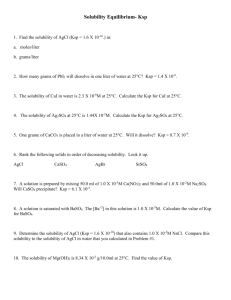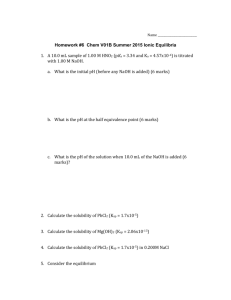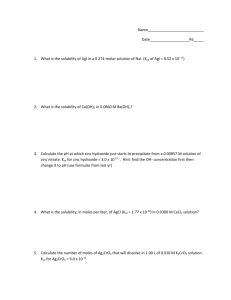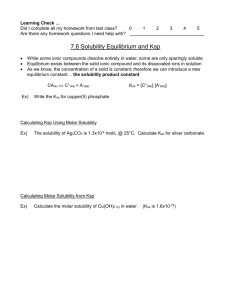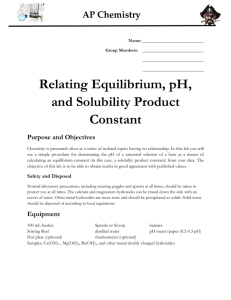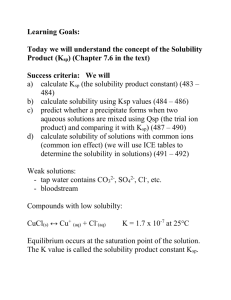Test4
advertisement
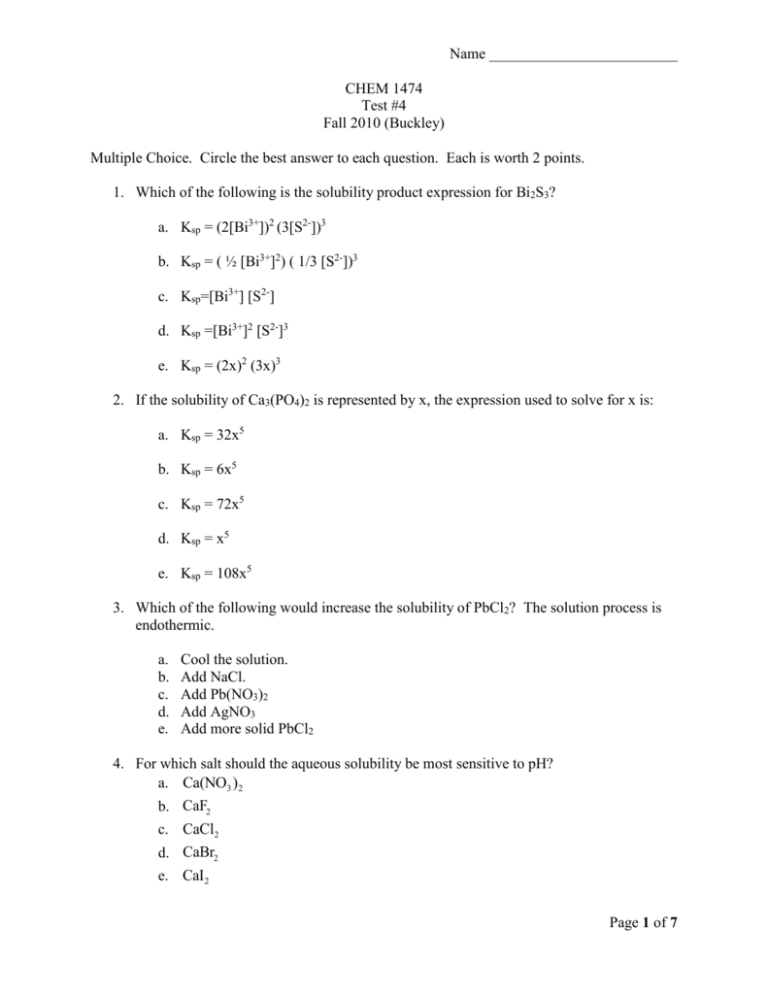
Name _________________________ CHEM 1474 Test #4 Fall 2010 (Buckley) Multiple Choice. Circle the best answer to each question. Each is worth 2 points. 1. Which of the following is the solubility product expression for Bi2S3? a. Ksp = (2[Bi3+])2 (3[S2-])3 b. Ksp = ( ½ [Bi3+]2) ( 1/3 [S2-])3 c. Ksp=[Bi3+] [S2-] d. Ksp =[Bi3+]2 [S2-]3 e. Ksp = (2x)2 (3x)3 2. If the solubility of Ca3(PO4)2 is represented by x, the expression used to solve for x is: a. Ksp = 32x5 b. Ksp = 6x5 c. Ksp = 72x5 d. Ksp = x5 e. Ksp = 108x5 3. Which of the following would increase the solubility of PbCl2? The solution process is endothermic. a. b. c. d. e. Cool the solution. Add NaCl. Add Pb(NO3)2 Add AgNO3 Add more solid PbCl2 4. For which salt should the aqueous solubility be most sensitive to pH? a. Ca(NO3 )2 b. CaF2 c. CaCl2 d. CaBr2 e. CaI2 Page 1 of 7 5. What is the molar solubility of barium fluoride (BaF2 ) in water? The solubility-product constant for BaF2 is 1.7 10 6 at 25 °C. a. b. c. d. e. 6.5 104 1.2 10 2 1.8 10 3 7.5 103 5.7 107 6. What is the molar solubility of barium fluoride (BaF2) in a solution that is 0.050 M in NaF? The solubility product constant for BaF2 is 1.7 × 10-6. a. b. c. d. e. 7.5 × 10-3 6.8 × 10-4 1.2 × 10-2 9.5 × 10-3 6.5 × 10-3 7. __________ is reduced in the following reaction: Cr 2 O 7 2 6S 2 O 32 14H 2Cr 3 3S 4 O 6 2 7H 2 O a. b. c. d. e. Cr6+ S2+ H+ O2S4O62- 8. Which substance is serving as the reducing agent in the following reaction? 14H + Cr 2 O 7 2 3Ni 3Ni 2 2Cr 3 7H 2 O a. b. c. d. e. Ni H+ Cr2O72H2O Ni2+ 9. The electrode at which oxidation occurs is called the ______________ a. b. c. d. e. oxidizing agent cathode reducing agent anode voltaic cell Page 2 of 7 10. The more __________ the value of E°red , the greater the driving force for reduction. a. b. c. d. e. positive negative exothermic endothermic extensive 11. The balanced half-reaction in which sulfate ion is reduced to sulfite ion is a __________ process. a. b. c. d. e. four-electron one-electron two-electron three-electron six-electron 12. A particular process has negative values of both ΔH and ΔS. Under what temperature conditions would the reaction be spontaneous? a. b. c. d. e. at all temperatures at no temperatures at temperatures below ΔH/ΔS at temperatures above ΔH/ΔS there is insufficient information to be certain 13. Which one of the following processes produces a decrease in the entropy of the system? a. b. c. d. e. boiling water to form steam dissolution of solid KCl in water mixing of two gases into one container freezing water to form ice melting ice to form water 14. A reaction that is not spontaneous at low temperature can become spontaneous at high temperature if H is __________ and S is __________. a. b. c. d. e. +, + -, +, -, + +, 0 15. Suppose one writes out a redox reaction. Which of the following statements is consistent with the reaction being spontaneous to the right? a. ΔG < 0, E < 0, and K >1 b. ΔG > 0, E < 0, and K >0 c. ΔG < 0, E > 0, and K < 1 d. ΔG < 0, E > 0, and K > 1 e. ΔG > 0, E > 0, and K = 1 Page 3 of 7 Show your work on the following problems to receive full credit. 16. (6 points) Complete and balance the redox equations below in the indicated medium (acid or base). a. 17. I 2 ( s ) OCl (aq) IO3 (aq) Cl (aq) MnO4 (aq) Br (aq) MnO2 ( s) BrO3 (aq) (acidic solution) (basic solution) Page 4 of 7 17. (8 points) A voltaic cell uses the following reaction (reduction potentials at bottom of page): 4 Fe2+ (aq) + O2 (g) + 4 H+ (aq) → 4 Fe3+ (aq) + 2 H2O (ℓ) a. What is the standard potential for this cell? b. What is the potential of this cell when [Fe2+] = 0.065 M, [Fe3+] = 0.0050 M, PO2 = 0.25 atm, and the pH of the solution is 4.75? c. Is the system described in part b at equilibrium, shifting to the left or shifting to the right? O2 (g) + 4 H+ (aq) + 4 e- → 2 H2O (ℓ) E° = +1.23 V Fe3+ (aq) + e- → Fe2+ (aq) E° = +0.77 V Page 5 of 7 18. (8 points) Consider the reaction: 2 PCl3 (g) + O2 (g) → 2 POCl3 (g) a. Using the data below, find ΔG°, ΔH°, and ΔS° for the reaction. b. Is the reaction spontaneous at 298 K? Explain your reasoning. c. Over what temperature range would the reaction be spontaneous? PCl3 (g) O2 (g) POCl3 (g) Thermodynamic Quantities for Problem 18 ΔG°f (kJ/mol) ΔH° (kJ/mol) S° (J/mol∙K) -269.6 -288.07 311.7 0 0 205.0 -502.5 -542.2 325 Page 6 of 7 Potentially Useful Equations and Scratch Paper Name ________________________ G G RT ln Q E E 0.0592 log Q n G RT ln K G nFE Page 7 of 7




